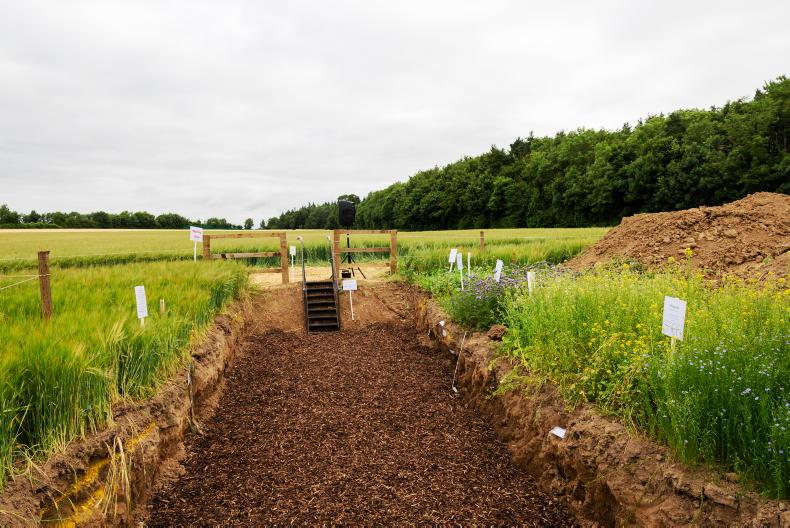The soil pit attracted a lot of attention at the Crops and Technology open day last week. It demonstrated the impacts of compaction, cultivation and cover crops on soil structure and health.
There was a visible plough pan 15-30cm deep in the soil. There was also clear compaction across the soil below where the headland tramlines were located through the crop. The compaction appeared in a platey structure across the soil with larger than normal soil aggregates.
It was highlighted that a plough pan would lead to lateral root growth and poor drainage. Only roots from trees or hedgerows have the ability to break through a plough pan over time.
A question came from the crowd on incorporating straw or leaving it on the soil surface. Teagasc’s Luis Lopez-Sangil noted that incorporating the straw into the soil is better use of the material. If left on top of the soil the straw will not be readily available to soil microbes or earthworms and nutrients may be lost.

Soil Pit at Crops and Technology \ Claire Nash
Incorporation of straw into the soil means that there is better soil contact for the microbes and faster decomposition, and also better long-term use of the material.
Research conducted at Teagasc Oak Park by Jack Perry investigated the results of trials where winter barley varieties that are tolerant to barley yellow dwarf virus (BYDV) were sprayed and not sprayed with an insecticide.
The varieties used in Ireland are bred in the UK and mainland Europe where BYDV strains are different to Ireland. The research was to ensure that the varieties are suitable for the Irish climate.
Three susceptible varieties
There were eight tolerant varieties and three susceptible varieties sown. Some crops were sprayed for aphids and others were left unsprayed.
In trials where the varieties were left unsprayed, the tolerant varieties had reduced levels of BYDV symptoms and had a reduced level of yield loss in comparison to trials where the tolerant varieties were sprayed.
There was also a reduced level of BYDV symptoms and yield loss for the unsprayed tolerant varieties compared to the unsprayed susceptible varieties.
Varieties have shown promise for Irish conditions and their increasing use shows that they are a viable tool for growers going forward.
The soil pit attracted a lot of attention at the Crops and Technology open day last week. It demonstrated the impacts of compaction, cultivation and cover crops on soil structure and health.
There was a visible plough pan 15-30cm deep in the soil. There was also clear compaction across the soil below where the headland tramlines were located through the crop. The compaction appeared in a platey structure across the soil with larger than normal soil aggregates.
It was highlighted that a plough pan would lead to lateral root growth and poor drainage. Only roots from trees or hedgerows have the ability to break through a plough pan over time.
A question came from the crowd on incorporating straw or leaving it on the soil surface. Teagasc’s Luis Lopez-Sangil noted that incorporating the straw into the soil is better use of the material. If left on top of the soil the straw will not be readily available to soil microbes or earthworms and nutrients may be lost.

Soil Pit at Crops and Technology \ Claire Nash
Incorporation of straw into the soil means that there is better soil contact for the microbes and faster decomposition, and also better long-term use of the material.
Research conducted at Teagasc Oak Park by Jack Perry investigated the results of trials where winter barley varieties that are tolerant to barley yellow dwarf virus (BYDV) were sprayed and not sprayed with an insecticide.
The varieties used in Ireland are bred in the UK and mainland Europe where BYDV strains are different to Ireland. The research was to ensure that the varieties are suitable for the Irish climate.
Three susceptible varieties
There were eight tolerant varieties and three susceptible varieties sown. Some crops were sprayed for aphids and others were left unsprayed.
In trials where the varieties were left unsprayed, the tolerant varieties had reduced levels of BYDV symptoms and had a reduced level of yield loss in comparison to trials where the tolerant varieties were sprayed.
There was also a reduced level of BYDV symptoms and yield loss for the unsprayed tolerant varieties compared to the unsprayed susceptible varieties.
Varieties have shown promise for Irish conditions and their increasing use shows that they are a viable tool for growers going forward.







 This is a subscriber-only article
This is a subscriber-only article










SHARING OPTIONS: